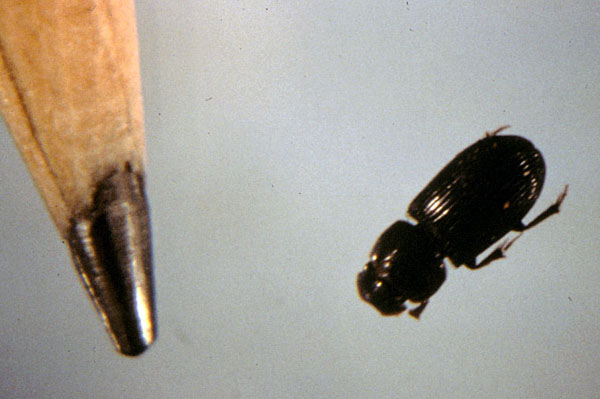Issue 3, May 8, 2009
Black Turfgrass Ataenius
Black turfgrass ataenius is primarily a pest of highly-irrigated, highly-maintained turfgrass. Although the white grubs can be found in home lawns, they are rarely numerous enough to be a problem. They are a serious problem on golf courses, particularly in high-irrigated areas such as greens, tees, and swales in fairways.
Black turfgrass ataenius grubs look similar to other white grubs and cause similar root-feeding damage. They cause brown turf areas that can easily be pulled up with the first generation damage being heaviest in late June and early July. However, the grubs are smaller than other grubs, with full size being about one-quarter inch long. They do not have a raster pattern on the underside of the last abdominal segment. Instead, they have two large pads in that location.
Adults overwinter under leaf litter and other debris in moist areas. On a golf course, this is commonly under trees between fairways where drainage from the fairways keeps the area moist much of the year. In the spring, as bridal wreath spirea is in full bloom, the beetles fly onto the greens, tees, and fairways to lay eggs. The beetles are cylindrical and about one-quarter inch long. When they emerge from pupae, they are brownish and take several days to mature to black. When the beetles are on the course laying eggs in the soil, they are easily seen in the clippings baskets of the greens mowers. This is the scouting method that we recommend.

If beetles are numerous in the clippings baskets, apply a long-lasting grub insecticide about two weeks later. Effective insecticides include imidacloprid (Merit), halofenozide (Mach 2), thiamethoxam (Meridian), clothianidin (Arena), and chloranitroniliprole (Acelepryn). These insecticides should control the black turfgrass ataenius first generation grubs and remain effective to control second generation black turfgrass ataenius grubs as well as Japanese beetle and masked chafer grubs in August.--Phil Nixon
Author:
Phil Nixon